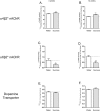Neuronal Nicotinic Acetylcholine Receptor Modulators Reduce Sugar Intake
- PMID: 27028298
- PMCID: PMC4814119
- DOI: 10.1371/journal.pone.0150270
Neuronal Nicotinic Acetylcholine Receptor Modulators Reduce Sugar Intake
Abstract
Excess sugar consumption has been shown to contribute directly to weight gain, thus contributing to the growing worldwide obesity epidemic. Interestingly, increased sugar consumption has been shown to repeatedly elevate dopamine levels in the nucleus accumbens (NAc), in the mesolimbic reward pathway of the brain similar to many drugs of abuse. We report that varenicline, an FDA-approved nicotinic acetylcholine receptor (nAChR) partial agonist that modulates dopamine in the mesolimbic reward pathway of the brain, significantly reduces sucrose consumption, especially in a long-term consumption paradigm. Similar results were observed with other nAChR drugs, namely mecamylamine and cytisine. Furthermore, we show that long-term sucrose consumption increases α4β2 * and decreases α6β2* nAChRs in the nucleus accumbens, a key brain region associated with reward. Taken together, our results suggest that nAChR drugs such as varenicline may represent a novel treatment strategy for reducing sugar consumption.
Conflict of interest statement
Figures




References
-
- WHO. Obesity: preventing and managing the global epidemic. Report of a WHO consultation. World Health Organization technical report series. 2000;894:i-xii, 1–253. Epub 2001/03/10. 11234459. - PubMed
Publication types
MeSH terms
Substances
Associated data
Grants and funding
LinkOut - more resources
Full Text Sources
Other Literature Sources

